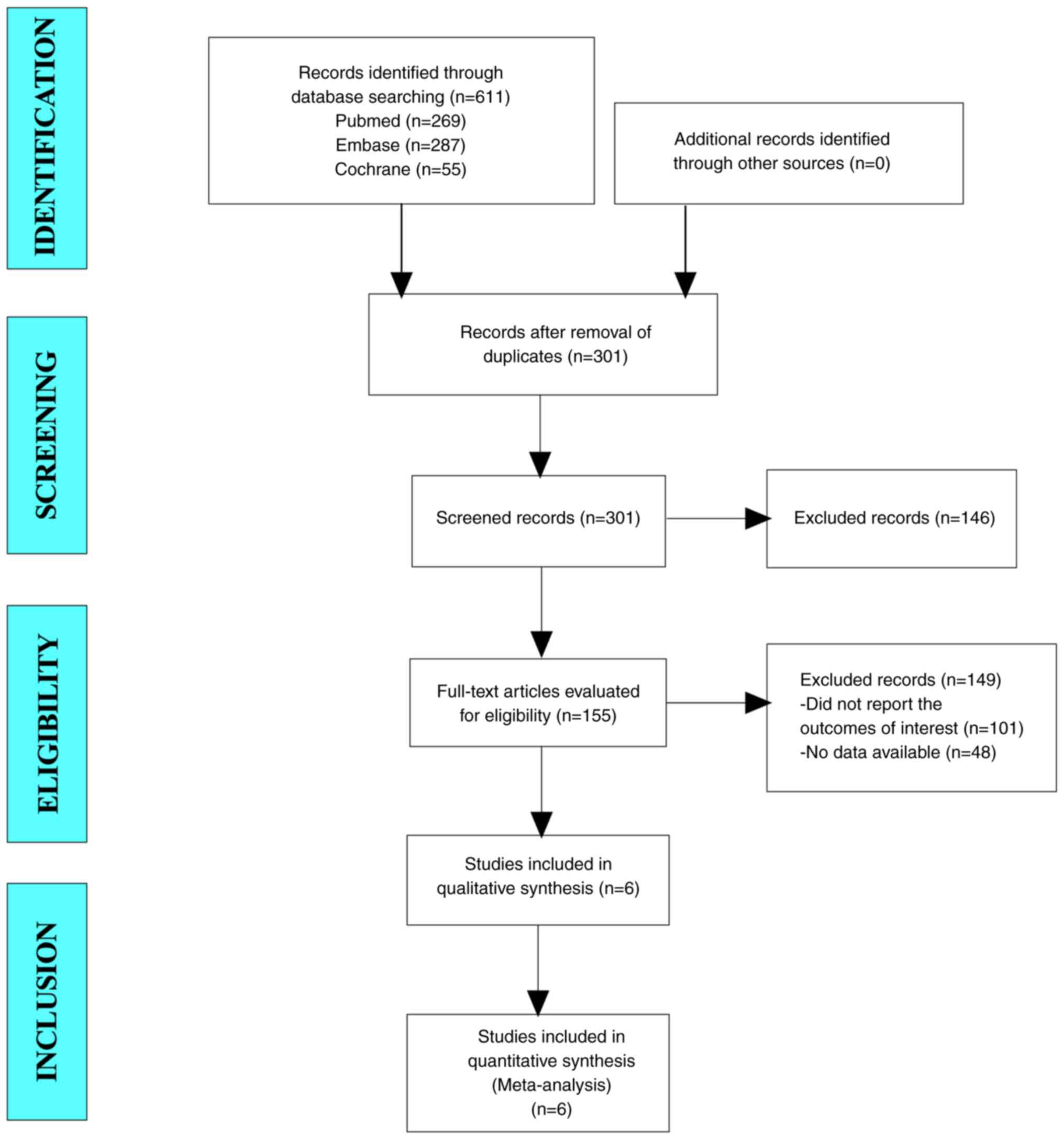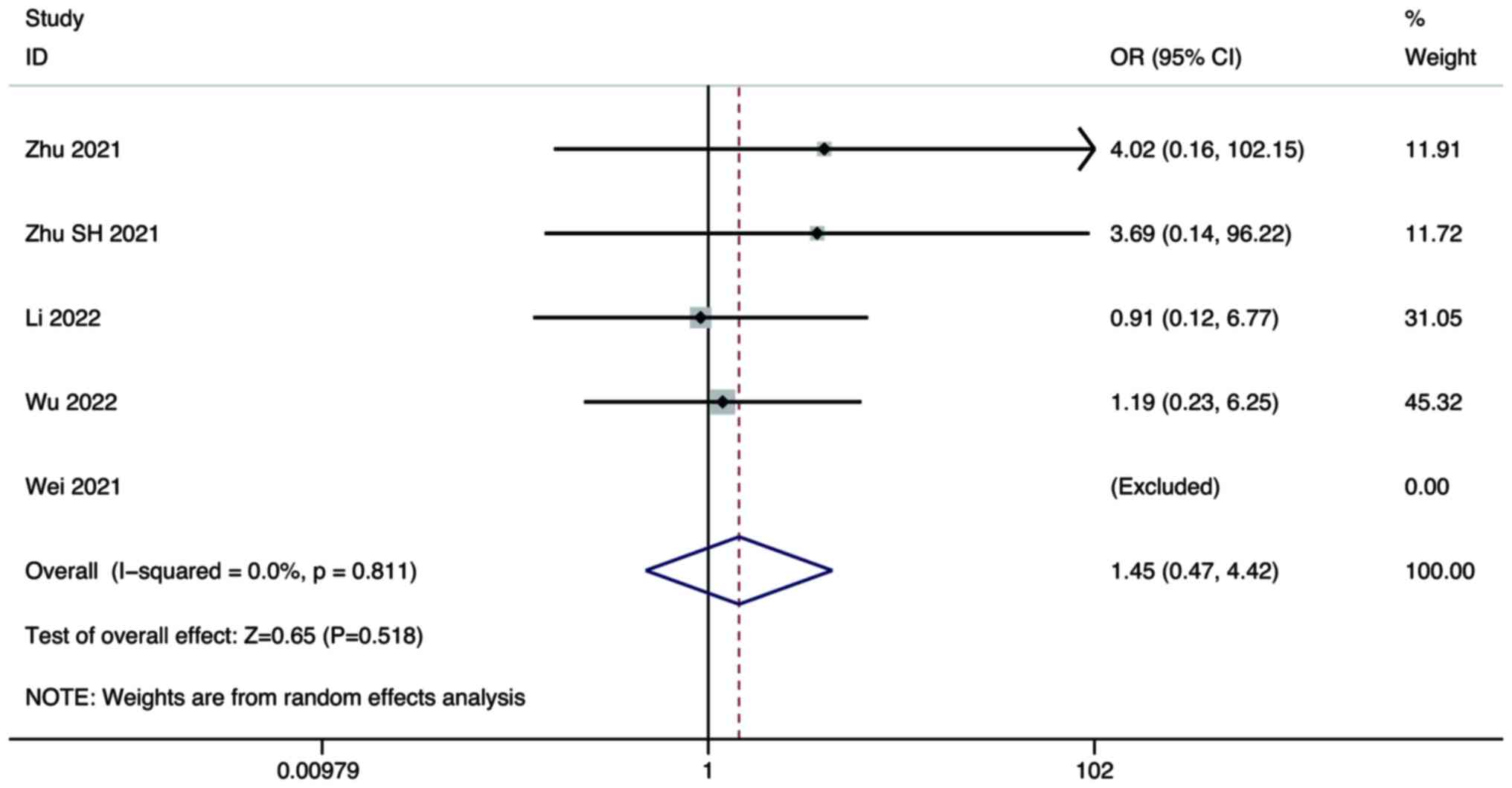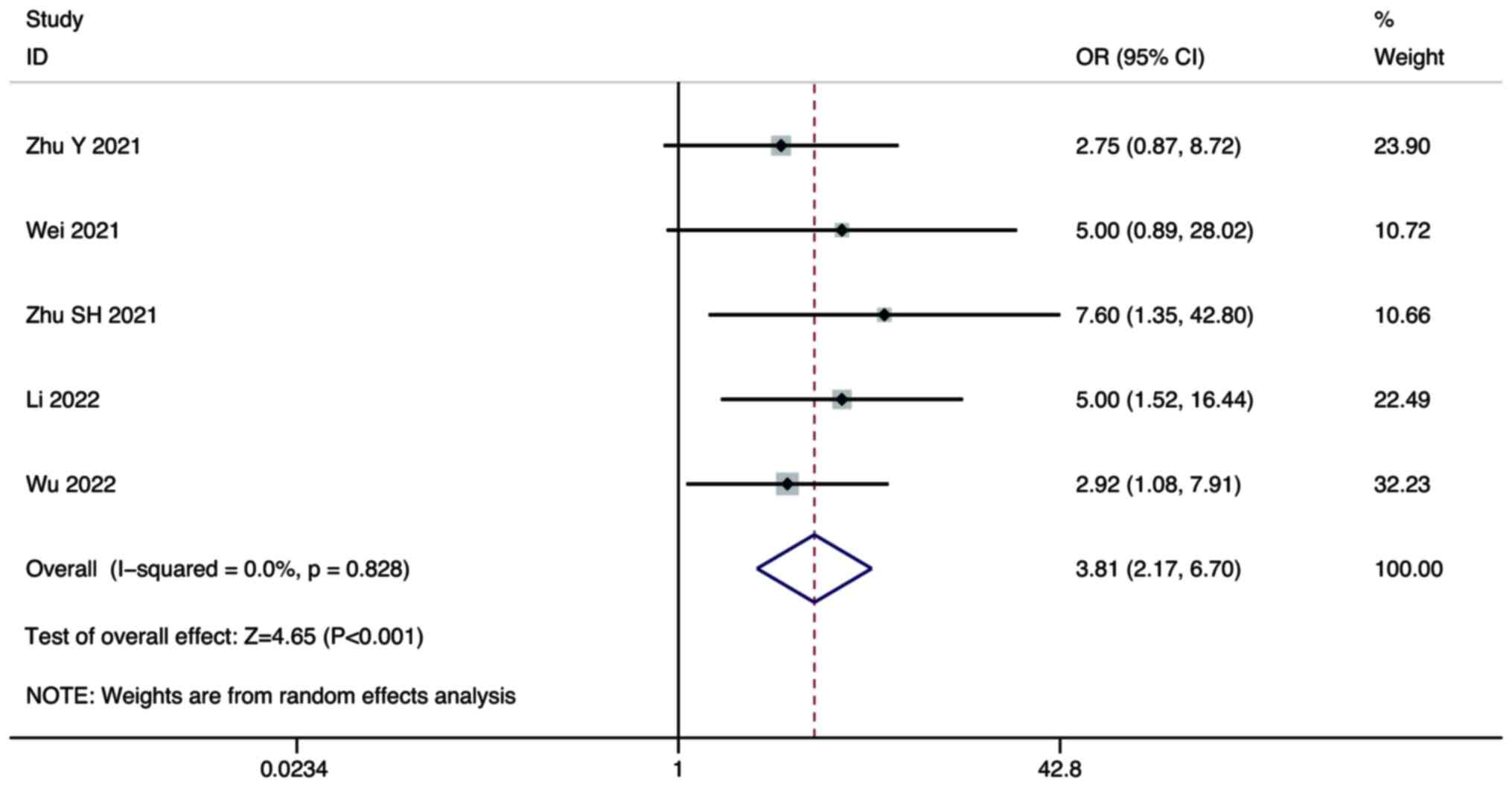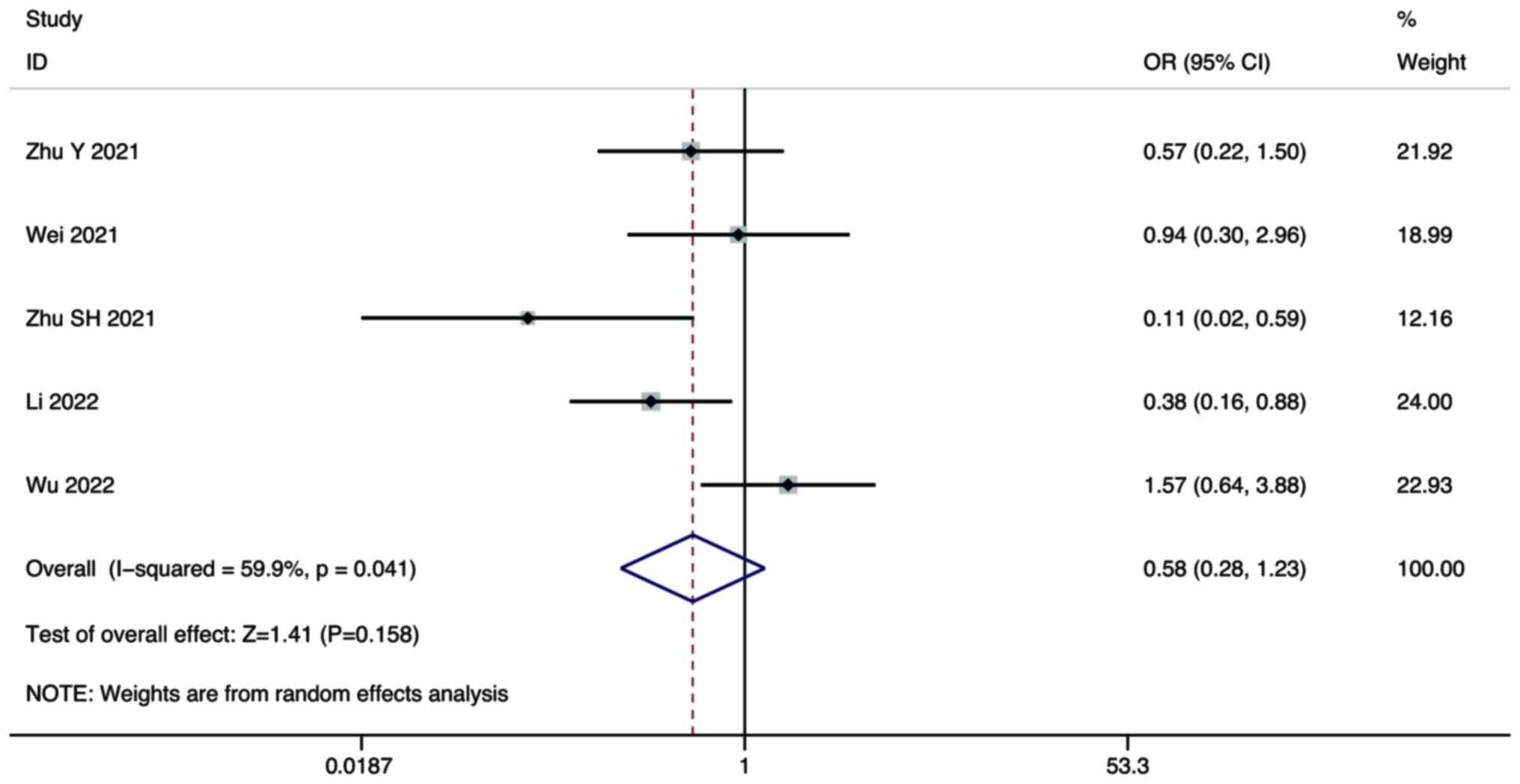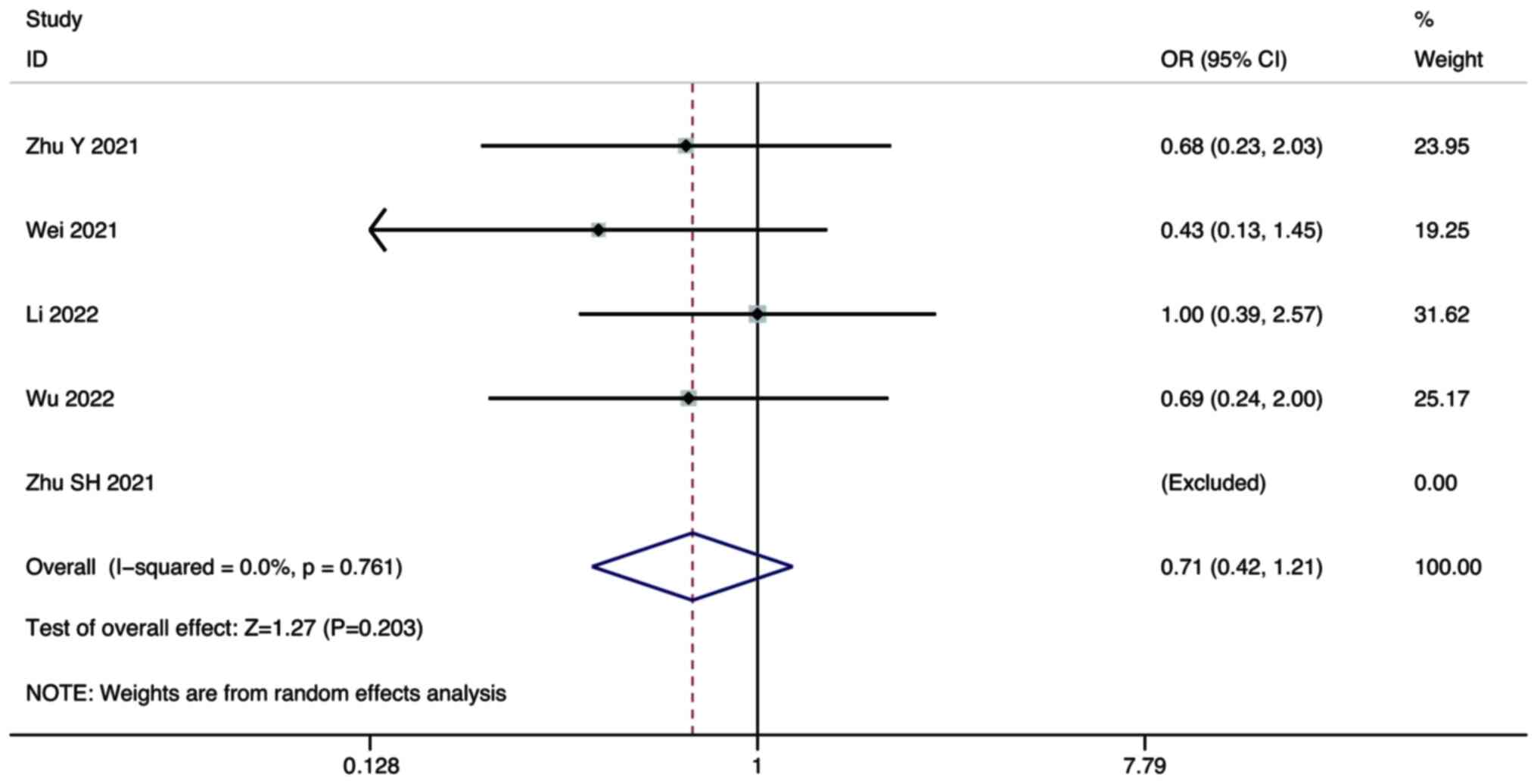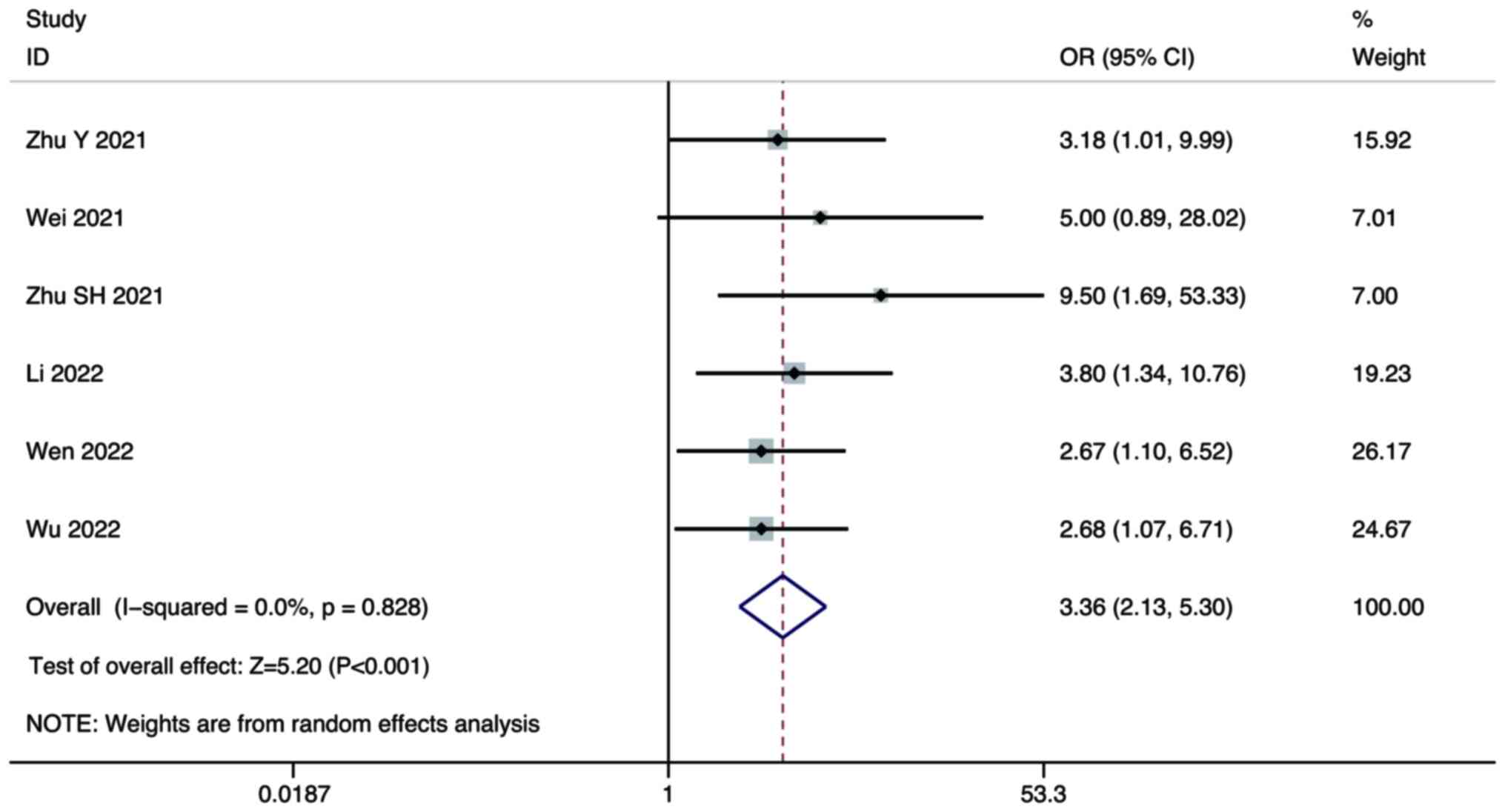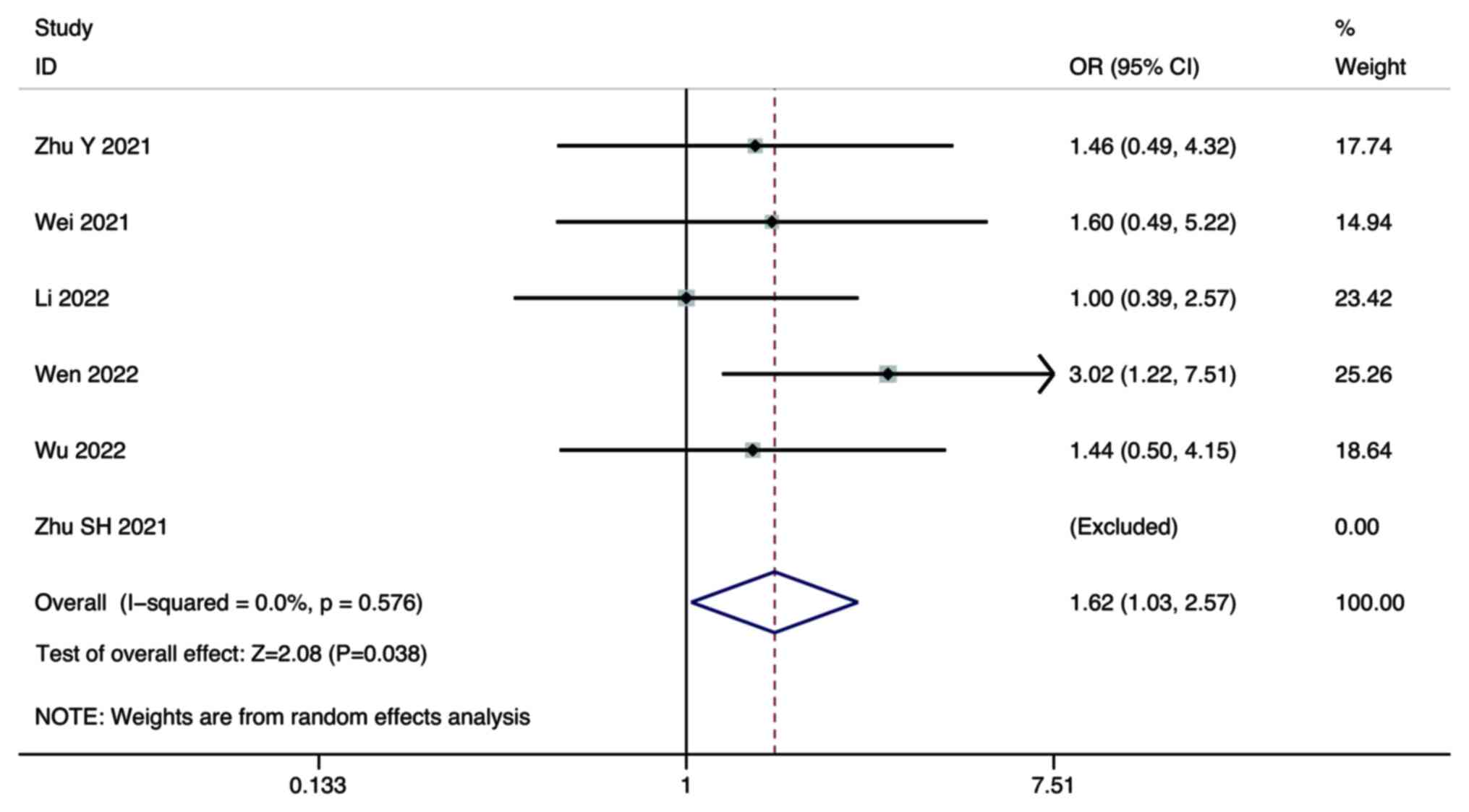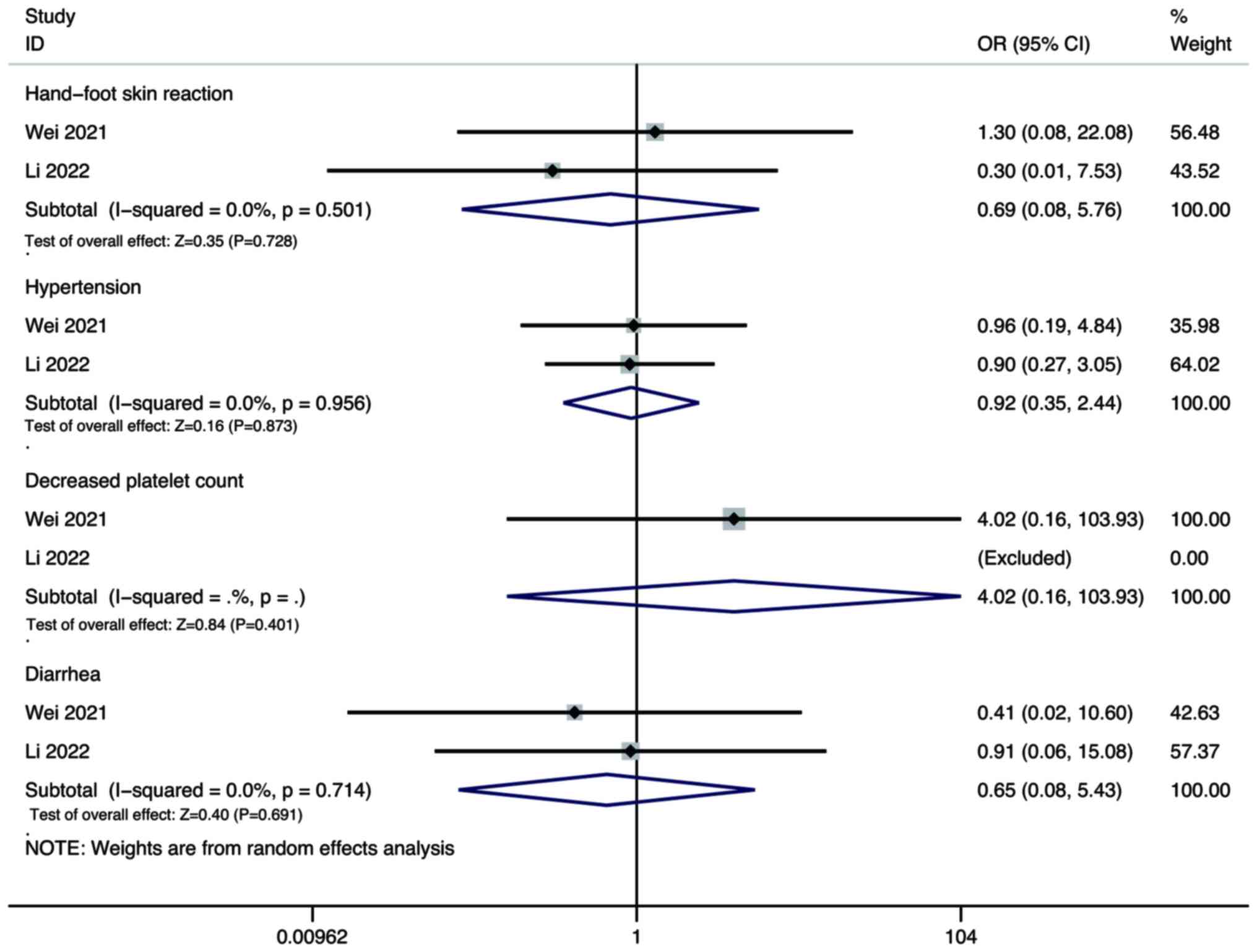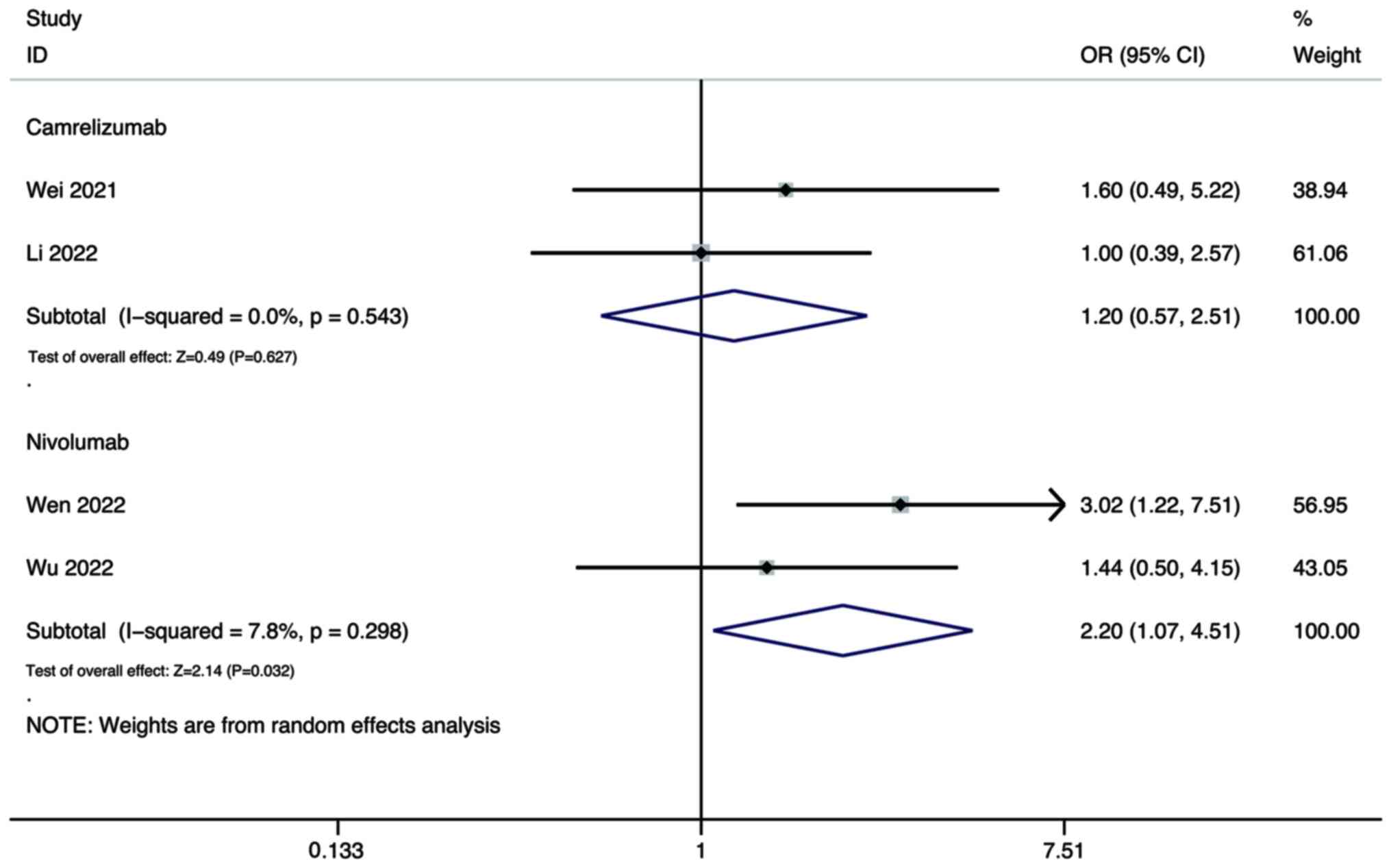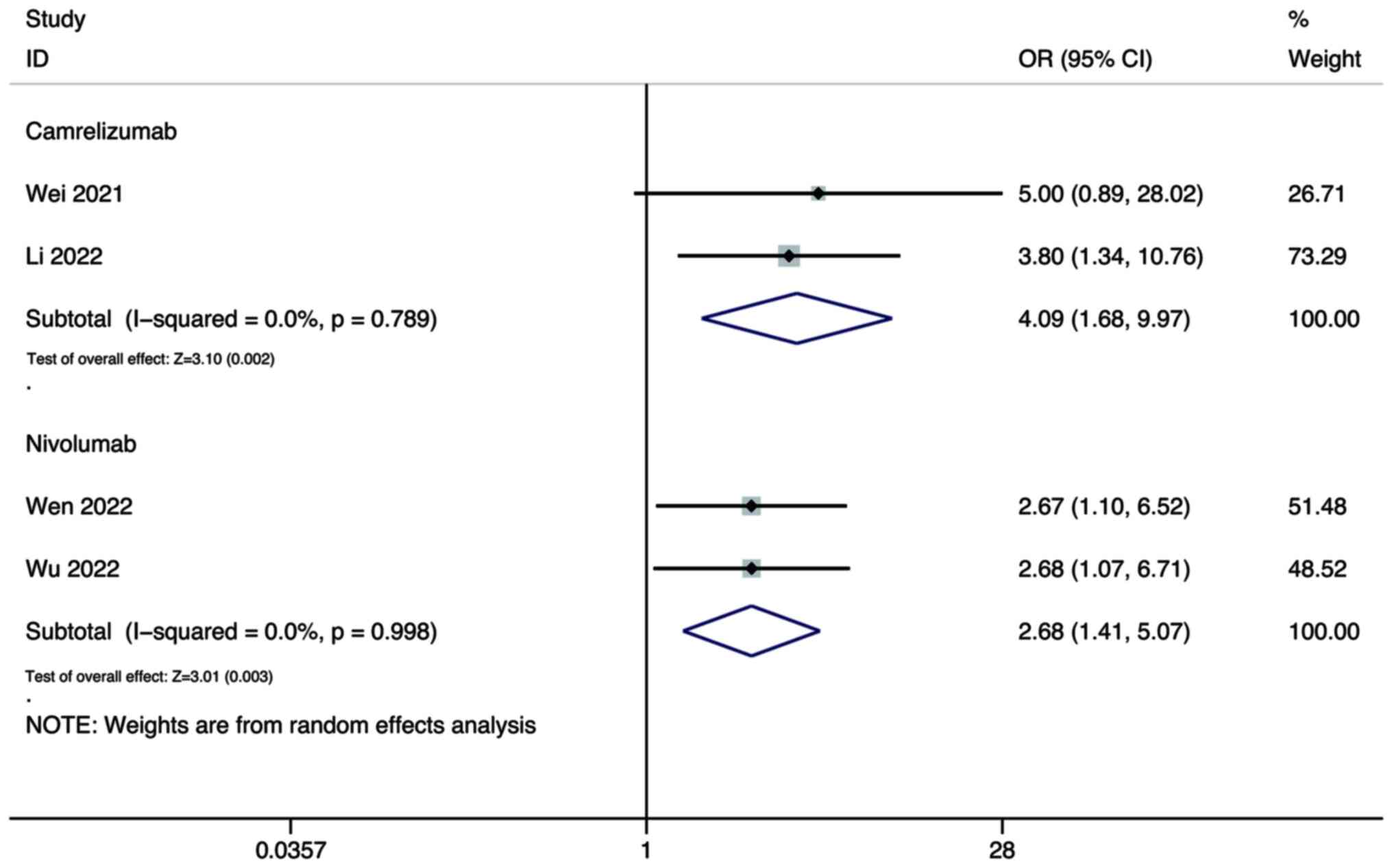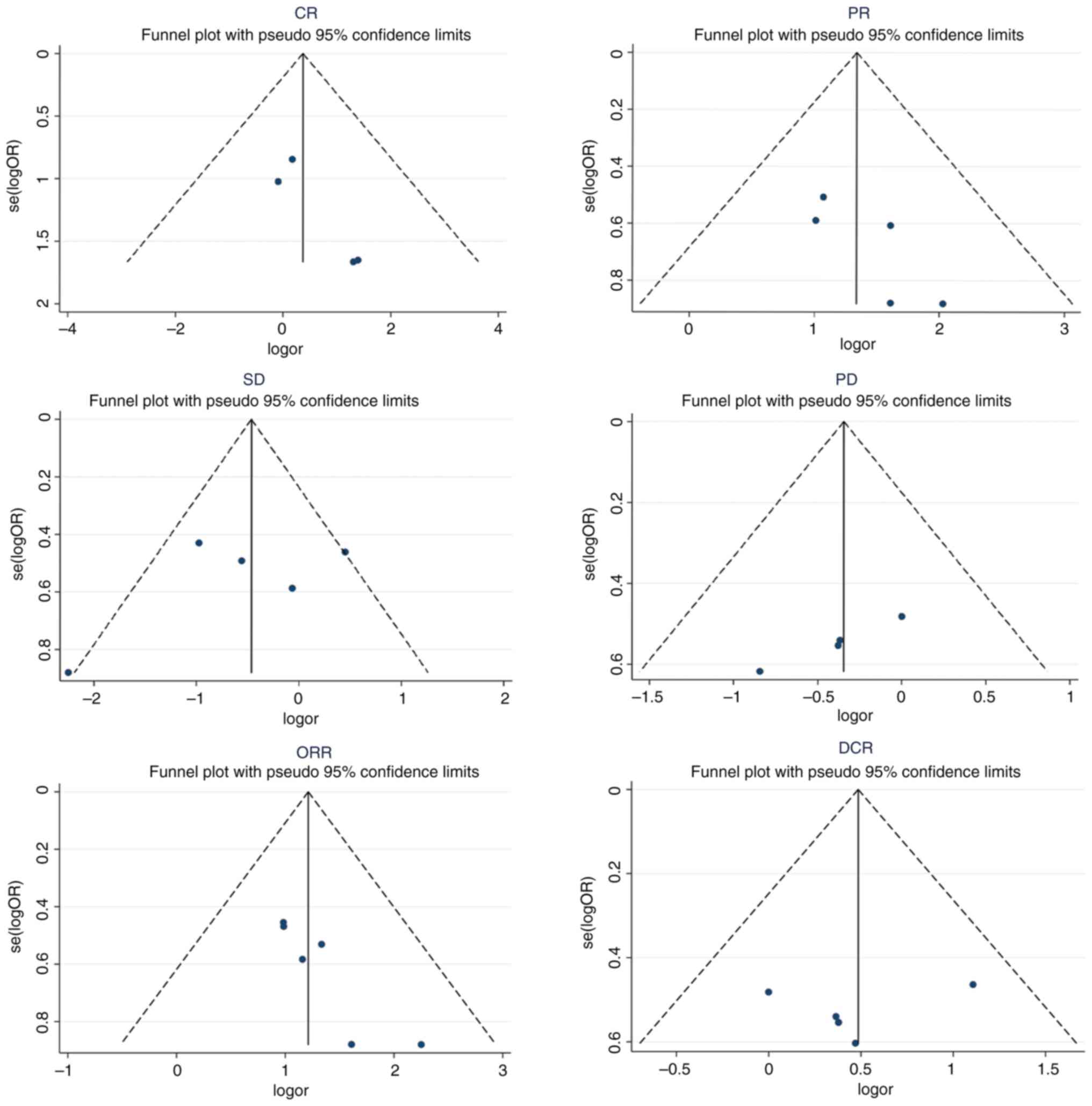Efficacy and safety of lenvatinib combined with PD‑1/PD‑L1 inhibitors in the treatment of hepatocellular carcinoma: A meta‑analysis and systematic review
- Authors:
- Published online on: May 14, 2024 https://doi.org/10.3892/ol.2024.14445
- Article Number: 312
-
Copyright: © Zhang et al. This is an open access article distributed under the terms of Creative Commons Attribution License.
Abstract
Introduction
Hepatocellular carcinoma (HCC) is the sixth most common malignancy and fourth leading cause of cancer-related death worldwide. According to the National Cancer Institute SEER database, the average 5-year survival rate of patients with HCC in the USA is 19.6%, but can be as low as 2.5% for advanced, metastatic disease (1,2). A total of >90% of HCC cases develop in individuals with preexisting chronic liver conditions, making this cancer a significant contributor to morbidity and mortality among patients with cirrhosis (3). The poor prognosis for patients with HCC has traditionally stemmed from a combination of late-stage diagnosis and limited treatment effectiveness at advanced stages.
Systemic therapy continues to be the preferred treatment modality for patients diagnosed with unresectable HCC (uHCC). Among the available options, tyrosine kinase inhibitors (TKIs), such as sorafenib and lenvatinib, demonstrate similar overall survival (OS) outcomes for patients with uHCC (range, 10–13.5 months) (4–6). Lenvatinib, a multi-TKI, acts on receptors that include platelet-derived growth factor receptor-α, rearranged during transfection and tyrosine-kinase receptor (7). This inhibition effectively curtails angiogenesis and hinders tumour growth. Its robust suppression of the fibroblast growth factor receptor (FGFR) pathway is the key approach to managing liver cancer. In the REFLECT trial, lenvatinib exhibited superior response rates, extended progression-free survival and demonstrated non-inferiority in OS compared with sorafenib (4). Although lenvatinib has shown superiority to sorafenib in improving OS in patients with HCC in clinical trials (clinical trials nos. NCT01761266 and NCT04127396), its effectiveness has been limited by resistance and side effects (4). Further improvements in efficacy are required.
In recent years, immune checkpoint inhibitors have been widely studied in various cancers. Programmed death-1 (PD-1) and PD-ligand 1 (PD-L1) checkpoint inhibitors have emerged as promising treatment strategies for HCC (8). Currently, an increasing body of evidence indicates that most TKIs exert anti-angiogenic activity in cancer treatment, and when used in combination with immunosuppressants, including PD-1 blockade, sirolimus and everolimus, they exhibit a synergistic effect (9). TKIs can promote the expression of major histocompatibility complex antigens on tumour cells, thereby enhancing sensitivity to T-cell-mediated tumour cell elimination. This effect is particularly pronounced when used in combination with PD-1 inhibitors as it facilitates T-cell-mediated tumour cell destruction (10). In vitro studies have shown that lenvatinib and PD-1 inhibitors can exert synergistic antitumour effects (11,12). In addition, an early clinical trial regarding the combination of lenvatinib and PD-1 inhibitors for advanced HCC has reported favourable safety and effectiveness (13). However, to date, evidence-based information on the efficacy and safety of lenvatinib combined with PD-1/PD-L1 inhibitors in treating HCC is lacking. A meta-analysis of the clinical survival indicators, adverse reactions and safety of lenvatinib combined with PD-1 inhibitors in liver cancer treatment was conducted, providing objective and effective evidence-based medical information for clinical use. The present study is anticipated to guide clinical application.
Materials and methods
Literature inclusion and exclusion criteria
The inclusion criteria were the following: i) Regarding the study design, randomized controlled trials (RCTs), non-RCTs and single-arm trial studies related to the combined treatment of lenvatinib and PD-1/PD-L1 inhibitors for HCC were included and the language was limited to English; ii) regarding the study subjects, patients with a confirmed diagnosis of primary liver cancer were included without restrictions on sex, race, or age; iii) regarding interventions, in the control group, patients received lenvatinib monotherapy, while in the experimental group, patients received combination therapy using lenvatinib and PD-1/PD-L1 inhibitors for liver cancer; and iv) regarding outcome measures, complete response (CR), partial response (PR), stable disease (SD), progression disease (PD), objective response rate (ORR), disease control rate (DCR), safety measures, including adverse reactions, were assessed. The exclusion criteria were the following: i) Case reports, review articles and previously published duplicate studies; ii) animal experiments and basic research; iii) literature that did not align with the inclusion criteria; iv) studies with flawed research designs or treatment measures unrelated to the experiment; and v) literature that could not provide valid information and data.
Literature search
The Embase, PubMed and Cochrane Library databases were used for literature search from inception to September 2023. The search terms were a combination of Medical Subject Heading terms and entry terms. The search terms included ‘lenvatinib’ AND ‘nivolumab’, ‘pembrolizumab’, ‘tremelimumab, ‘atezolizumab, ‘durvalumab’, ‘camrelizumab’, ‘PD1’, ‘PDL1’ AND ‘hepatocellular carcinoma’.
Data extraction
Two researchers independently conducted the screening and data extraction based on the aforementioned inclusion and exclusion criteria. In case of discrepancies between the two researchers, disagreements were resolved through discussion or, if needed, by consulting a third researcher.
Literature quality assessment
Two researchers independently conducted literature quality evaluations using the Newcastle-Ottawa Scale (NOS) for cohort studies (14). NOS includes four items (4 points) for ‘Research Subject Selection’, one item (2 points) for ‘Comparability between Groups’ and three items (3 points) for ‘Result Measurement’. It has a full score of 9 points, with ≥7 regarded as high-quality literature and <7, low-quality literature. The meta-analysis was performed based on the related items of the Preferred Reporting Items for Systematic Reviews and Meta-analysis guidelines (15).
Data synthesis and statistical analysis
Data were analysed using Review Manager (version 5.3; http://revman.cochrane.org) and processed using STATA 15.1 (StataCorp LP). The differences in treatment outcomes in RCTs were assessed using the relative risk (RR) and its 95% confidence interval (CI). I2 was used to evaluate cell heterogeneity. If the test for heterogeneity was P≥0.1 and I2≤50%, homogeneity between studies was indicated, and the studies were analysed together using a fixed effects model. If the test was P<0.1 and I2>50%, significant heterogeneity within this group was indicated; if there was a difference, the source of the difference was identified using sensitivity analysis. A random-effects model was used for the pooling effect in the present meta-analysis. Publication bias was analysed using funnel plots and Egger's test with P>0.05 indicating no publication bias.
Results
Literature search results
A total of 611 articles were collected for the present study. After excluding duplicate studies, 301 articles remained of which, 155 articles were identified following eligibility screening of titles and abstracts. After reading the full text, 101 studies that did not report the outcomes of interest and 48 studies with no data available were excluded. Finally, six studies were included in the present meta-analysis (Fig. 1).
Baseline characteristics and quality assessment of the included studies
Six cohort studies were included in the present meta-analysis. The sample size range was 39–92 and the total number of patients was 427; 203 in the combination treatment group and 224 in the lenvatinib group. The age range of patients in the combination treatment group was 50.5–58.5 years, and that in the lenvatinib monotherapy group was 50.0–63.7 years suggesting that ages were comparable. The PD-1/PD-L1 inhibitors used included camrelizumab, nivolumab, toripalimab, sintilimab, tislelizumab and pembrolizumab. The NOS scores used for quality assessment were all >7, indicating that the quality of the included studies was high (Table I) (16–21).
Results of the meta-analysis
CRFive studies compared the CR of combination therapy using lenvatinib and PD-1/PD-L1 inhibitors, with lenvatinib monotherapy in the treatment of HCC. A random-effects model was used for the meta-analysis. The pooled results showed that there was no significant difference in the CR between combination therapy and lenvatinib monotherapy (OR, 1.45; 95% CI, 0.47–4.42; P=0.518; Fig. 2).
PR
Five studies compared the PR of combination therapy and monotherapy in the treatment of HCC. A random-effect model was used for the meta-analysis. The pooled results showed that the PR of combination therapy was significantly higher than that of lenvatinib monotherapy (OR, 3.81; 95% CI, 2.17–6.70; P<0.001; Fig. 3).
SD
Five studies compared the SD of combination therapy and lenvatinib monotherapy in the treatment of HCC. A random-effect model was used for the meta-analysis. The pooled results showed that there was no significant difference in the SD between combination therapy and lenvatinib monotherapy (OR, 0.58; 95% CI, 0.28–1.23; P=0.158; Fig. 4).
PD
Five studies compared the PD of combination therapy and monotherapy in the treatment of HCC. A random-effect model was used for the meta-analysis. The pooled results showed that there was no significant difference in the PD between combination therapy and lenvatinib monotherapy (OR, 0.71; 95% CI, 0.42–1.21; P=0.203; Fig. 5).
ORR
Six studies compared the ORR of combination therapy and monotherapy in the treatment of HCC. A random-effect model was used for the meta-analysis. The pooled results showed that the ORR of combination therapy was significantly higher than that of lenvatinib monotherapy (OR, 3.36; 95% CI, 2.13–5.30; P<0.001; Fig. 6).
DCR
Six studies compared the DCR of combination therapy and monotherapy in the treatment of HCC. A random-effect model was used for the meta-analysis. The pooled results showed that the DCR of combination therapy was significantly higher than that of lenvatinib monotherapy (OR, 1.62; 95% CI, 1.03–2.57; P=0.038; Fig. 7).
Adverse events
Pooled results showed that there was no significant difference in the incidence rate of hand-foot skin reaction (OR, 0.69; 95% CI, 0.08–5.76; P=0.728), hypertension (OR, 0.92; 95% CI, 0.35–2.44; P=0.873), decreased platelet count (OR, 4.02; 95% CI, 0.16–103.93; P=0.401), and diarrhoea (OR, 0.65; 95% CI, 0.08–5.43; P=0.691) between the combination therapy group and the lenvatinib monotherapy group (Fig. 8).
Subgroup analysis
In addition, subgroup analyses of the ORR and DCR based on different PD-1/PD-L1 inhibitors were performed.
For the ORR, the pooled results showed that the DCR of combination therapy using lenvatinib and either camrelizumab (OR, 4.09; 95% CI, 1.68–9.97; P=0.002) or nivolumab (OR, 2.68; 95% CI, 1.41–5.07; P=0.003) were all significantly higher than that of lenvatinib monotherapy (Fig. 9).
As for the DCR, the pooled results showed that the DCR of combination therapy using lenvatinib and nivolumab was significantly higher than that of lenvatinib monotherapy (OR, 2.20; 95% CI, 1.07–4.51; P=0.032; Fig. 9), while there was no significant difference between combination therapy using lenvatinib and camrelizumab, and monotherapy (OR, 1.20; 95% CI, 0.57–2.51; P=0.627; Fig. 10).
Sensitivity analysis
A sensitivity analysis was performed to exclude every trial individually before performing a combined analysis of the remaining trials. It was found that no study had a great influence on the results, suggesting that the results of the present study are reliable and stable.
Publication bias
The funnel plots of the CR, PR, SD, PD and DCR were symmetrically distributed, and the P-values of Egger's test were 0.097, 0.111, 0.412, 0.203 and 0.633, respectively, indicating there was no obvious publication bias in these studies. Meanwhile, the funnel plot of the ORR was not completely symmetric (P=0.015), suggesting that there may be publication bias in the study (Fig. 11).
Discussion
The growing body of evidence underscores the significance of FGF pathway signalling activation in HCC development and advancement (22). Matsuki et al (23) conducted a thorough investigation, using in vitro experiments with human HCC cell lines and in vivo studies with mouse xenograft models. That study confirmed that the FGF19-FGFR4 axis plays a pivotal role in markedly augmenting the proliferation and growth of HCC. These discoveries provide a compelling explanation for the treatment responses witnessed with lenvatinib, a potent inhibitor designed to target FGFR 1–4, particularly in advanced HCC cases (4).
Lenvatinib, similar to other multi-kinase inhibitors, has demonstrated its capacity for immunomodulation (24). Notably, VEGF-A and β-FGF have been identified as potent inducers of immune checkpoint markers while concurrently inhibiting the secretion of IFN-γ and granzyme B, consequently dampening T-cell cytotoxicity (25). Notably, lenvatinib can reverse this immunosuppressive effect (11). Additionally, Adachi et al (25) elucidated that the activation of FGFR signalling leads to the suppression of the JAK/STAT pathway, resulting in IFN-γ secretion reduction. Nevertheless, the use of lenvatinib, which inhibits FGFR signalling, efficiently reinstates the stimulation of IFN-γ (25). Furthermore, multiple studies have shown that lenvatinib elevates the proportion of activated CD8+ T cells that secrete IFN-γ and granzyme B (25,26). The antitumour efficacy of lenvatinib was diminished in immunodeficient mice when CD8+ T cells were depleted (26). Conversely, lenvatinib reduced the percentage of monocytes and the population of macrophages, including tumour-associated macrophages (TAMs) (25,26). In summary, lenvatinib has been observed to enhance antitumour immunity by increasing the population of IFN-γ-producing CD8+ T-cells and reducing the presence of TAMs. These findings suggest that lenvatinib may hold the potential for combination therapy with immunotherapy approaches.
The present meta-analysis included six studies to analyse the efficacy and safety of lenvatinib combined with PD-1/PD-L1 inhibitors and lenvatinib monotherapy in HCC treatment. In summary, the current study demonstrates the potential synergistic effects of combining lenvatinib with PD-1/PD-L1 inhibitors in HCC treatment. The improved ORR and DCR observed in the combination therapy group compared with those in the lenvatinib monotherapy group suggest that this approach is promising for enhancing treatment outcomes. However, the increased efficacy primarily manifested as PR, and the difference in CRs between the combination therapy and lenvatinib monotherapy groups was not statistically significant. The failure of combination therapy to significantly enhance CR rates suggests that specific biological or microenvironmental factors, such as immunosuppressive cells (27) and proinflammatory cytokines (28), in HCC may contribute to resistance against complete eradication. Understanding the mechanisms behind this limitation could direct future therapeutic strategies. Further research and clinical trials are warranted to explore the mechanistic basis of these observations, optimize patient selection criteria, and assess the long-term benefits and potential toxicities associated with this therapeutic approach.
The present subgroup analyses, which focused on the PD-1/PD-L1 inhibitors nivolumab and camrelizumab provided valuable insights into the variations in DCR associated with these specific combinations. The pooled results clearly demonstrated that combination therapy using lenvatinib and nivolumab led to a significantly higher DCR than that of lenvatinib monotherapy. This finding underscores the potential synergy between lenvatinib and nivolumab in effectively controlling the progression of HCC. The improved DCR suggests that this combination may be particularly beneficial for patients with HCC who seek enhanced disease control and tumour burden reduction. By contrast, the current analysis did not reveal a significant difference in DCR between combination therapy using lenvatinib and camrelizumab, and lenvatinib monotherapy. While this result might suggest a limited additive effect when using lenvatinib and camrelizumab in terms of DCR, it is noteworthy that clinical outcomes may be influenced by various factors, including patient heterogeneity and tumour characteristics. Overall, these subgroup analyses emphasize the need for the careful selection of PD-1/PD-L1 inhibitors when combining them with lenvatinib in the treatment of HCC. The choice of PD-1/PD-L1 inhibitor could significantly impact therapeutic response, and further research is warranted to explore the underlying mechanisms behind these observed differences. Personalized treatment approaches, tailored to individual patient profiles, may ultimately provide the most effective outcomes in the context of combination therapies for HCC.
In addition, the pooled results showed that there was no significant difference in the incidence rate of adverse events from combination therapy using lenvatinib and PD-1/PD-L1 inhibitors, and lenvatinib monotherapy in the treatment of HCC, suggesting that patients should be fully informed of possible adverse reactions before treatment and that further treatment should be carried out after patient consent. Timely treatment is needed to prevent possible adverse reactions.
The current study still had some limitations: i) The sample size of the included literature was small, which may lead to the risk of bias in the results; a large sample and multicentre RCT studies are needed; ii) the intervention was lenvatinib combined with PD-1 inhibitors, however, due to the difference in dosage between studies and the different response effects of patients with liver cancer to related drugs, the results of the present meta-analysis were affected to some extent; and iii) there is a possible publication bias in the analysis of the ORR, hence, it is necessary to continue to include new studies in future studies to exclude the risk of bias.
Compared with lenvatinib monotherapy, lenvatinib combined with PD-1/PD-L1 inhibitors significantly improved the ORR, mainly PR, and DCR in patients with HCC. It is noteworthy that lenvatinib was mainly combined with nivolumab to increase the DCR of lenvatinib monotherapy for HCC. In addition, there was no significant difference in the incidence rate of adverse reactions between combination therapy and lenvatinib monotherapy for HCC.
Acknowledgements
Not applicable.
Funding
Funding: No funding was received.
Availability of data and materials
The datasets are available from the corresponding author on reasonable request.
Authors' contributions
YL and BZ wrote the manuscript and created the figures. BZ and LS participated in the acquisition and analysis of data. YL conceived the final version of manuscript. YL and BZ confirm the authenticity of all the raw data. All authors read and approved the final manuscript.
Ethics approval and consent to participate
Not applicable.
Patient consent for publication
Not applicable.
Competing interests
The authors declare that they have no competing interests.
References
|
Brown ZJ, Tsilimigras DI, Ruff SM, Mohseni A, Kamel IR, Cloyd JM and Pawlik TM: Management of hepatocellular carcinoma: A review. JAMA Surg. 158:410–420. 2023. View Article : Google Scholar : PubMed/NCBI | |
|
Chidambaranathan-Reghupaty S, Fisher PB and Sarkar D: Hepatocellular carcinoma (HCC): Epidemiology, etiology and molecular classification. Adv Cancer Res. 149:1–61. 2021. View Article : Google Scholar : PubMed/NCBI | |
|
Kumar A, Acharya SK, Singh SP, Arora A, Dhiman RK, Aggarwal R, Anand AC, Bhangui P, Chawla YK, Gupta SD, et al: 2019 update of Indian national association for study of the liver consensus on prevention, diagnosis, and management of hepatocellular carcinoma in India: The puri II recommendations. J Clin Exp Hepatol. 10:43–80. 2020. View Article : Google Scholar : PubMed/NCBI | |
|
Kudo M, Finn RS, Qin S, Han KH, Ikeda K, Piscaglia F, Baron A, Park JW, Han G, Jassem J, et al: Lenvatinib versus sorafenib in first-line treatment of patients with unresectable hepatocellular carcinoma: A randomised phase 3 non-inferiority trial. Lancet. 391:1163–1173. 2018. View Article : Google Scholar : PubMed/NCBI | |
|
Llovet JM, Ricci S, Mazzaferro V, Hilgard P, Gane E, Blanc JF, de Oliveira AC, Santoro A, Raoul JL, Forner A, et al: Sorafenib in advanced hepatocellular carcinoma. N Engl J Med. 359:378–390. 2008. View Article : Google Scholar : PubMed/NCBI | |
|
Zhao Y, Zhang YN, Wang KT and Chen L: Lenvatinib for hepatocellular carcinoma: From preclinical mechanisms to anti-cancer therapy. Biochim Biophys Acta Rev Cancer. 1874:1883912020. View Article : Google Scholar : PubMed/NCBI | |
|
Ikeda M, Okusaka T, Mitsunaga S, Ueno H, Tamai T, Suzuki T, Hayato S, Kadowaki T, Okita K and Kumada H: Safety and pharmacokinetics of lenvatinib in patients with advanced hepatocellular carcinoma. Clin Cancer Res. 22:1385–1394. 2016. View Article : Google Scholar : PubMed/NCBI | |
|
El-Khoueiry AB, Sangro B, Yau T, Crocenzi TS, Kudo M, Hsu C, Kim TY, Choo SP, Trojan J, Welling THR, et al: Nivolumab in patients with advanced hepatocellular carcinoma (CheckMate 040): An open-label, non-comparative, phase 1/2 dose escalation and expansion trial. Lancet. 389:2492–2502. 2017. View Article : Google Scholar : PubMed/NCBI | |
|
Fukumura D, Kloepper J, Amoozgar Z, Duda DG and Jain RK: Enhancing cancer immunotherapy using antiangiogenics: Opportunities and challenges. Nat Rev Clin Oncol. 15:325–340. 2018. View Article : Google Scholar : PubMed/NCBI | |
|
Cheng AL, Hsu C, Chan SL, Choo SP and Kudo M: Challenges of combination therapy with immune checkpoint inhibitors for hepatocellular carcinoma. J Hepatol. 72:307–319. 2020. View Article : Google Scholar : PubMed/NCBI | |
|
Deng H, Kan A, Lyu N, Mu L, Han Y, Liu L, Zhang Y, Duan Y, Liao S, Li S, et al: Dual vascular endothelial growth factor receptor and fibroblast growth factor receptor inhibition elicits antitumor immunity and enhances programmed cell death-1 checkpoint blockade in hepatocellular carcinoma. Liver Cancer. 9:338–357. 2020. View Article : Google Scholar : PubMed/NCBI | |
|
Kudo M: Scientific rationale for combined immunotherapy with PD-1/PD-L1 antibodies and VEGF inhibitors in advanced hepatocellular carcinoma. Cancers (Basel). 12:10892020. View Article : Google Scholar : PubMed/NCBI | |
|
Finn RS, Ikeda M, Zhu AX, Sung MW, Baron AD, Kudo M, Okusaka T, Kobayashi M, Kumada H, Kaneko S, et al: Phase Ib study of lenvatinib plus pembrolizumab in patients with unresectable hepatocellular carcinoma. J Clin Oncol. 38:2960–2970. 2020. View Article : Google Scholar : PubMed/NCBI | |
|
Cook DA and Reed DA: Appraising the quality of medical education research methods: The medical education research study quality instrument and the newcastle-ottawa scale-education. Acad Med. 90:1067–1076. 2015. View Article : Google Scholar : PubMed/NCBI | |
|
Bernardo WM: PRISMA statement and PROSPERO. Int Braz J Urol. 43:383–384. 2017. View Article : Google Scholar : PubMed/NCBI | |
|
Zhu Y, Sun P, Wang K, Xiao S and Cheng Y, Li X, Wang B, Li J, Yu W and Cheng Y: Efficacy and safety of lenvatinib monotreatment and lenvatinib-based combination therapy for patients with unresectable hepatocellular carcinoma: A retrospective, real-world study in China. Cancer Cell Int. 21:5032021. View Article : Google Scholar : PubMed/NCBI | |
|
Wei F, Huang Q, He J, Luo L and Zeng Y: Lenvatinib plus Camrelizumab versus Lenvatinib monotherapy as post-progression treatment for advanced hepatocellular carcinoma: A short-term prognostic study. Cancer Manag Res. 13:4233–4240. 2021. View Article : Google Scholar : PubMed/NCBI | |
|
Zhu S, Liu C, Dong Y, Shao J, Liu B and Shen J: A retrospective study of lenvatinib monotherapy or combined with programmed cell death protein 1 antibody in the treatment of patients with hepatocellular carcinoma or intrahepatic cholangiocarcinoma in China. Front Oncol. 11:7886352021. View Article : Google Scholar : PubMed/NCBI | |
|
Li Q, Cao M, Yuan G, Cheng X, Zang M, Chen M, Hu X, Huang J, Li R, Guo Y, et al: Lenvatinib Plus Camrelizumab vs. Lenvatinib Monotherapy as first-line treatment for unresectable hepatocellular carcinoma: A multicenter retrospective cohort study. Front Oncol. 12:8097092022. View Article : Google Scholar : PubMed/NCBI | |
|
Wen S, Zeng J, Zhong L, Ye J and Lai X: The efficacy and adverse effects of nivolumab and lenvatinib in the treatment of advanced hepatocellular carcinoma. Cell Mol Biol (Noisy-le-grand). 68:53–57. 2022. View Article : Google Scholar : PubMed/NCBI | |
|
Wu WC, Lin TY, Chen MH, Hung YP, Liu CA, Lee RC, Huang YH, Chao Y and Chen SC: Lenvatinib combined with nivolumab in advanced hepatocellular carcinoma-real-world experience. Invest New Drugs. 40:789–797. 2022. View Article : Google Scholar : PubMed/NCBI | |
|
Miura S, Mitsuhashi N, Shimizu H, Kimura F, Yoshidome H, Otsuka M, Kato A, Shida T, Okamura D and Miyazaki M: Fibroblast growth factor 19 expression correlates with tumor progression and poorer prognosis of hepatocellular carcinoma. BMC Cancer. 12:562012. View Article : Google Scholar : PubMed/NCBI | |
|
Matsuki M, Hoshi T, Yamamoto Y, Ikemori-Kawada M, Minoshima Y, Funahashi Y and Matsui J: Lenvatinib inhibits angiogenesis and tumor fibroblast growth factor signaling pathways in human hepatocellular carcinoma models. Cancer Med. 7:2641–2653. 2018. View Article : Google Scholar : PubMed/NCBI | |
|
Lin YY, Tan CT, Chen CW, Ou DL, Cheng AL and Hsu C: Immunomodulatory effects of current targeted therapies on hepatocellular carcinoma: Implication for the future of immunotherapy. Semin Liver Dis. 38:379–388. 2018. View Article : Google Scholar : PubMed/NCBI | |
|
Adachi Y, Kamiyama H, Ichikawa K, Fukushima S, Ozawa Y, Yamaguchi S, Goda S, Kimura T, Kodama K, Matsuki M, et al: Inhibition of FGFR reactivates IFNgamma signaling in tumor cells to enhance the combined antitumor activity of lenvatinib with Anti-PD-1 antibodies. Cancer Res. 82:292–306. 2022. View Article : Google Scholar : PubMed/NCBI | |
|
Kimura T, Kato Y, Ozawa Y, Kodama K, Ito J, Ichikawa K, Yamada K, Hori Y, Tabata K, Takase K, et al: Immunomodulatory activity of lenvatinib contributes to antitumor activity in the Hepa1-6 hepatocellular carcinoma model. Cancer Sci. 109:3993–4002. 2018. View Article : Google Scholar : PubMed/NCBI | |
|
Meng Y, Ye F, Nie P, Zhao Q, An L, Wang W, Qu S, Shen Z, Cao Z, Zhang X, et al: Immunosuppressive CD10+ALPL+ neutrophils promote resistance to anti-PD-1 therapy in HCC by mediating irreversible exhaustion of T cells. J Hepatol. 79:1435–1449. 2023. View Article : Google Scholar : PubMed/NCBI | |
|
Ma H, Kang Z, Foo TK, Shen Z and Xia B: Disrupted BRCA1-PALB2 interaction induces tumor immunosuppression and T-lymphocyte infiltration in HCC through cGAS-STING pathway. Hepatology. 77:33–47. 2023. View Article : Google Scholar : PubMed/NCBI |



